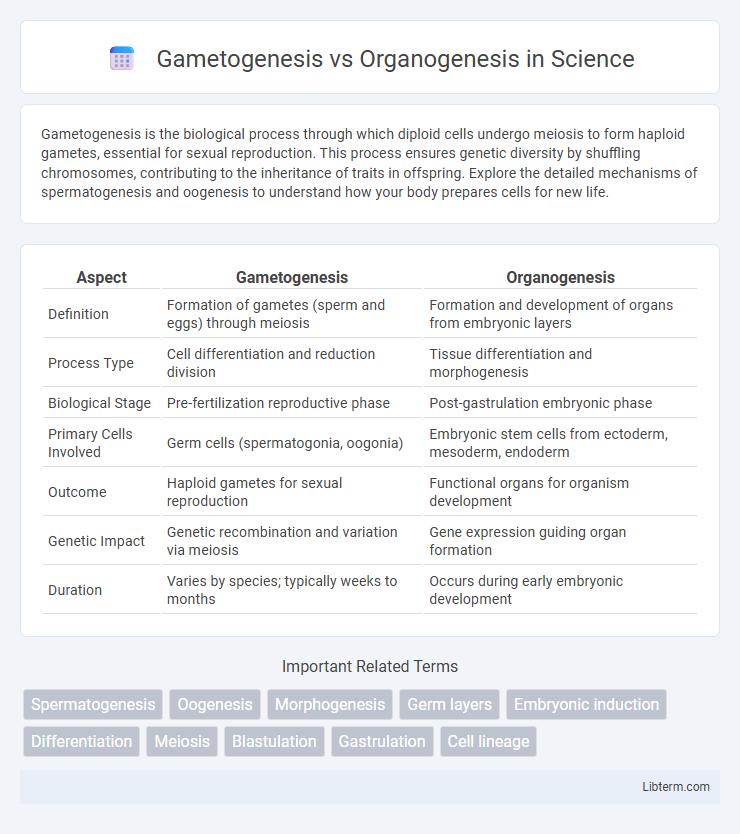Gametogenesis is the biological process through which diploid cells undergo meiosis to form haploid gametes, essential for sexual reproduction. This process ensures genetic diversity by shuffling chromosomes, contributing to the inheritance of traits in offspring. Explore the detailed mechanisms of spermatogenesis and oogenesis to understand how your body prepares cells for new life.
Table of Comparison
| Aspect | Gametogenesis | Organogenesis |
|---|---|---|
| Definition | Formation of gametes (sperm and eggs) through meiosis | Formation and development of organs from embryonic layers |
| Process Type | Cell differentiation and reduction division | Tissue differentiation and morphogenesis |
| Biological Stage | Pre-fertilization reproductive phase | Post-gastrulation embryonic phase |
| Primary Cells Involved | Germ cells (spermatogonia, oogonia) | Embryonic stem cells from ectoderm, mesoderm, endoderm |
| Outcome | Haploid gametes for sexual reproduction | Functional organs for organism development |
| Genetic Impact | Genetic recombination and variation via meiosis | Gene expression guiding organ formation |
| Duration | Varies by species; typically weeks to months | Occurs during early embryonic development |
Introduction to Gametogenesis and Organogenesis
Gametogenesis is the biological process through which diploid precursor cells develop into mature haploid gametes (sperm and eggs), essential for sexual reproduction and genetic diversity. Organogenesis refers to the phase in embryonic development where the three germ layers (ectoderm, mesoderm, endoderm) differentiate into specific organs and tissues, establishing the organism's functional anatomy. Both processes involve complex molecular signaling pathways regulated by genes crucial for proper development and viability.
Definitions and Key Concepts
Gametogenesis is the biological process by which diploid cells undergo meiosis to produce haploid gametes, such as sperm and eggs, essential for sexual reproduction. Organogenesis refers to the phase in embryonic development where the three germ layers--ectoderm, mesoderm, and endoderm--differentiate into specific organs and tissues. Key concepts in gametogenesis include meiosis, haploid cell formation, and genetic variation, while organogenesis involves cellular differentiation, morphogenesis, and organ system formation.
Distinct Stages of Gametogenesis
Gametogenesis involves the differentiation of germ cells into mature gametes through distinct stages: spermatogenesis in males produces sperm cells in the seminiferous tubules via mitosis, meiosis, and spermiogenesis, while oogenesis in females generates ova in ovarian follicles through stages of oogonia proliferation, primary oocyte arrest, and completion of meiosis post-fertilization. These processes ensure haploid chromosome formation, critical for sexual reproduction. Organogenesis, in contrast, refers to the formation and development of organs and tissues from the three germ layers during embryogenesis, separate from gamete formation.
Distinct Phases of Organogenesis
Organogenesis consists of distinct phases including the initiation of organ primordia, cellular differentiation where specific cell types develop, and morphogenesis that shapes the structure and function of organs. This process follows gametogenesis, which involves the formation of gametes through meiosis. The precise regulation of gene expression and cell signaling pathways during organogenesis ensures the formation of complex organs essential for organismal development.
Cellular Mechanisms Involved
Gametogenesis involves the cellular process of meiosis, where diploid germ cells undergo two successive divisions to produce haploid gametes, ensuring genetic diversity through recombination and chromosomal segregation. Organogenesis relies on regulated mitotic divisions, cell differentiation, and morphogenetic movements driven by signaling pathways such as Wnt, Hedgehog, and Notch to form complex tissues and organs from the embryonic germ layers. Both processes are tightly controlled by gene expression networks and epigenetic modifications that direct cell fate and function during development.
Genetic and Molecular Regulation
Gametogenesis involves tightly regulated genetic mechanisms such as the activation of meiosis-specific genes like SYCP3 and SPO11, ensuring reductional division and genetic diversity. Organogenesis relies on molecular signaling pathways including Wnt, Hedgehog, and Notch, which coordinate cell differentiation and tissue patterning through transcription factors like HOX genes. Both processes depend on epigenetic modifications and the precise control of gene expression to maintain developmental fidelity.
Functional Significance in Development
Gametogenesis produces haploid gametes essential for genetic diversity and sexual reproduction, ensuring the transfer of hereditary information to the next generation. Organogenesis involves the differentiation and formation of organs from the three germ layers, establishing the functional anatomy required for organismal survival. Both processes are critical for development, with gametogenesis enabling reproductive capability and organogenesis enabling physiological functionality.
Comparative Analysis: Gametogenesis vs Organogenesis
Gametogenesis and organogenesis are fundamental biological processes distinguished by their roles in development and reproduction; gametogenesis involves the formation of gametes (sperm and eggs) through meiosis, ensuring genetic diversity and continuity across generations, while organogenesis is the phase of embryonic development where organs and tissues are formed from germ layers through cell differentiation and morphogenesis. Gametogenesis is characterized by the production of haploid cells, critical for sexual reproduction, whereas organogenesis transforms the undifferentiated embryonic cells into specialized functional structures, essential for organismal viability. The comparative analysis highlights that gametogenesis primarily focuses on germ cell specialization and genetic recombination, whereas organogenesis orchestrates the spatial and temporal coordination of cellular processes to create complex organ systems.
Common Disorders and Abnormalities
Common disorders in gametogenesis include infertility caused by conditions such as azoospermia and oogenesis failure, which result from chromosomal abnormalities like Turner syndrome or Klinefelter syndrome. Organogenesis abnormalities often involve congenital malformations such as neural tube defects, congenital heart defects, and cleft palate, frequently linked to genetic mutations, environmental exposures, or nutrient deficiencies like folic acid. Both processes are critical in developmental biology, and disruptions can lead to significant reproductive and developmental health challenges.
Recent Advances and Future Perspectives
Recent advances in gametogenesis research have been driven by breakthroughs in single-cell RNA sequencing and CRISPR-Cas9 gene editing, enabling precise manipulation of germ cell development and identification of key regulatory genes. Organogenesis studies have benefited from organoid technology and 3D bioprinting, allowing for the replication of complex tissue structures and improved understanding of cellular interactions during organ formation. Future perspectives include integrating multi-omics data with artificial intelligence to enhance regenerative medicine and develop targeted therapies for developmental disorders.
Gametogenesis Infographic

 libterm.com
libterm.com